R.J. Stowell's Blog: rjsomeone, page 41
September 11, 2019
Forget? How Could You.
There is something almost rebellious in the man's posture, as though once faced with the inevitability of death, he decided to get on with it.
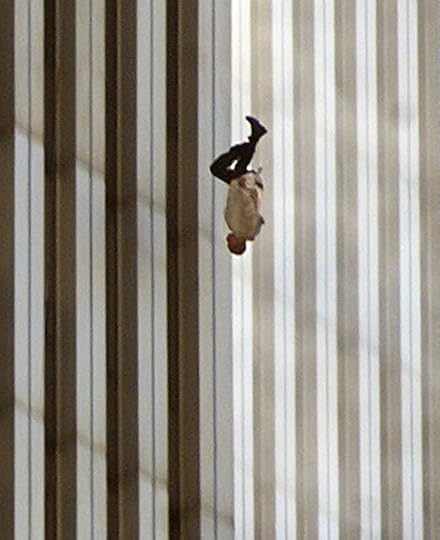

Published on September 11, 2019 10:08
The Abbey Road Medley
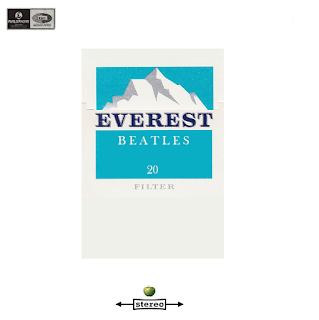 Abbey Road (working title, Everest, after the brand of cigarettes engineer Geoff Emerick smoked), which some consider the Beatles' finest LP (I would call it their most polished), was a bit of a miracle. After the disastrous Let It Be sessions and Apple's downfall, no one, not the Beatles or George Martin thought that there would be another album, and yet at Martin's encouragement and a vow that he'd only do it if the Beatles cooperated, production began on February 22, 1969, at EMI Studios. It was the Beatles' longest recording session, ending August 22, six months later. (The LP was released September 26 in the UK and on October 1 in the US.)
Abbey Road (working title, Everest, after the brand of cigarettes engineer Geoff Emerick smoked), which some consider the Beatles' finest LP (I would call it their most polished), was a bit of a miracle. After the disastrous Let It Be sessions and Apple's downfall, no one, not the Beatles or George Martin thought that there would be another album, and yet at Martin's encouragement and a vow that he'd only do it if the Beatles cooperated, production began on February 22, 1969, at EMI Studios. It was the Beatles' longest recording session, ending August 22, six months later. (The LP was released September 26 in the UK and on October 1 in the US.)Side 1 of Abbey Road was all about John, who wanted a more traditional LP, and for this writer, it remains one of those perfect album sides (give or a take an "Octopus's Garden"). Side 2 is a Paul thing and continues in a manner reflective of Sgt. Pepper, seemingly picking up where Pepper left off. Consisting of snippets of songs and compositions that weren't on The White Album, the Abbey Road medley is the most ambitious collective work the Beatles ever tackled. Beginning with track 3, "You Never Give Me Your Money," the production of the medley took from May 6 through August 23 (the Beatles rehearsed "She Came in Through the Bathroom Window" during the Let It Be sessions on January 22; feel free to add that into the timeline).
"You Never Give Me Your Money" contains the medley's binding theme. Opening with a piano intro that ends the side sixteen minutes later, Paul creates a mini-medley with piano, biting guitar solos, nursery rhyme vocals, and a mix of honky-tonk and vaudeville.
"Sun King," is a trippy Lennon track originally titled "Here Comes the Sun King," a play on Harrison's piece. Multiple layers of vocals and harmony include a bit of often incomprehensible Spanish lyrics.
"Mean Mr. Mustard" features Ringo's impeccable backbeat, though Lennon referred to the track as "a bit of crap I wrote in India" (when did Lennon ever really like anything he'd written?). John's snarky existentialism, or is it pessimism, is on full display in "Polythene Pam," on which Harrison's solo dominates. Bar "Why Don’t We Do It In the Road," "Polythene Pam" is the Beatles' quirkiest, most sexually motivated track, and as Lennon explained, is about a groupie and her sexual escapades in a plastic bag. "She Came In Through The Bathroom Window" is an upbeat pop single with a contagious chorus (covered by Joe Cocker in 1970). Paul purportedly wrote the track after a burglary in his home.

From there, "Golden Slumbers," based on the 17th Century poem, "Cradle Song" by Thomas Dekker, is an orchestral masterpiece. Violas, cellos, trumpets, and trombones showcase a lullaby that McCartney etches deep into one's soul. It's still a Beatles' song that brings me to tears, more so now than ever.
Bringing it full circle, which of course is the genius of the medley, is a reprise of "You Never Give Me Your Money." The Beatles come together for a final sing-a-long chorus and a broken guitar riff leads emotionally into "The End," which includes Ringo's only drum solo and features the magic of the Beatles when in perfect harmony. Killer guitar solos, a propulsive backbeat, and an intricate song structure make for one of the great moments in recorded musical history.
Amazingly, The New York Times called Abbey Road and the medley an "unmitigated disaster." Rolling Stone said it was "complicated instead of complex." Nonetheless, the LP topped the charts for 12 weeks and remains one of Rolling Stone's top ten albums; guess they changed their minds.
Published on September 11, 2019 04:54
September 10, 2019
Pilgrims of Woodstock
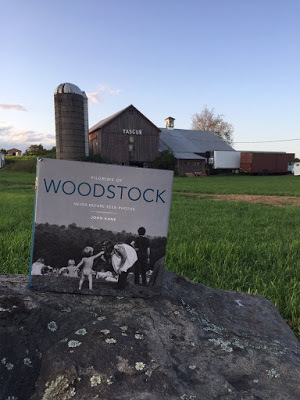 What a pleasure to host John Kane on DaybreakUSA this morning. John is the author of Pilgrims of Woodstock, a photo essay not about the Woodstock artists but the half-million strong. It features never before seen photographs by Richard F. Bellak and interviews with 30 diverse Woodstock attendees. If you're like me, you’ll treasure this beautifully presented work.John's big project, though, is set to come out in February, a bio on Bill Hanley, the audio engineer who brought the concert experience to life beginning with Dylan, The Beach Boys and The Beatles (oh yeah, and Woodstock). The Last Seat in the House; The Story of Hanley Sound is available for preorder on Amazon.You can order Pilgrims of Woodstock on Amazon or from your favorite bookseller (and don't forget to add Miles From Nowhere to your cart or get the Kindle Edition).
What a pleasure to host John Kane on DaybreakUSA this morning. John is the author of Pilgrims of Woodstock, a photo essay not about the Woodstock artists but the half-million strong. It features never before seen photographs by Richard F. Bellak and interviews with 30 diverse Woodstock attendees. If you're like me, you’ll treasure this beautifully presented work.John's big project, though, is set to come out in February, a bio on Bill Hanley, the audio engineer who brought the concert experience to life beginning with Dylan, The Beach Boys and The Beatles (oh yeah, and Woodstock). The Last Seat in the House; The Story of Hanley Sound is available for preorder on Amazon.You can order Pilgrims of Woodstock on Amazon or from your favorite bookseller (and don't forget to add Miles From Nowhere to your cart or get the Kindle Edition).www.pilgrimsofwoodstock.com
www.thelastseatinthehouse.comwww.10-am.blogspot.com#JohnKane #JohnKaneStudios #TheLastSeatintheHouse #PilgrimsofWoodstock #RJStowell #MilesFromNowhere #AMListen to the rebroadcast on iHeart Radio or at DaybreakUSA - https://www.iheart.com/podcast/966-daybreak-usa-30334029…
Keep on rockin’ in the free world...
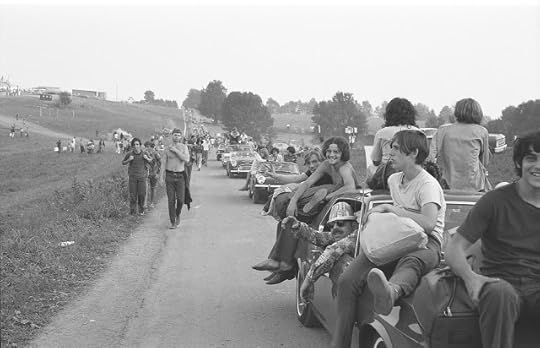
Published on September 10, 2019 07:53
September 9, 2019
Abbey Road
 50 years ago...
50 years ago......The Beatles were putting the final touches on an album tentatively titled Everest, after a British brand of cigarettes that engineer Geoff Emerick smoked. They'd each come up with exotic locations for the LP's cover shoot when for ease of operation, Paul suggested they simply go outside. He proceeded to draw a sketch of his idea. The zebra crossing (crosswalk) in front of the studio was about to become one of the most recognized sites in London. Not only would Paul's idea become the most famous album cover in history, from that moment on, EMI would be known as Abbey Road. The cover and back cover photos were photographed by Iain McMillan on August 8, 1969.
Back inside the studio, the Beatles and George Martin put the finishing touches on "Ending," a track that would inevitably be titled "The End."
The Beatles were in the studio for the last time on August 20, 1969, for the final mix of Lennon's "I Want You (She's So Heavy)." Their final moment together was two days later at Tittenhurst Park, Lennon's country estate, for a photo shoot.
As the story goes, Paul was dissatisfied with the inclusion of "Her Majesty" within the medley (originally between "Mean Mr. Mustard" and "Polythene Pam"). Nothing of the Beatles was ever discarded and so sound engineer John Curlander spliced the snippet to the end of the master tape, following 14 seconds of silence. The 23-second track was then included in the demo lacquer, and The Beatles and George Martin loved the tag. It was, essentially, the first "hidden" track, its title not appearing on the original pressings of the LP.
The Lyrics for the Beatles' Abbey Road Medley, the forerunner to songs like Paul's "Band on the Run" and Queen's "Bohemian Rhapsody" aren't featured on the LP. Unlike Sgt. Pepper, Magical Mystery Tour, and The White Album, the Abbey Road release featured no adornments, no cutouts, posters or lyrics. Just the music. In our next post, AM will analyze the lyrics; until then, here they are for your consideration.
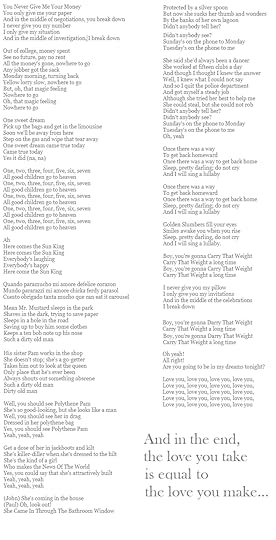
Published on September 09, 2019 07:17
September 8, 2019
Follow AM on FaceBook
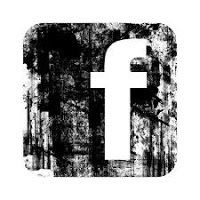
AM and Miles From Nowhere are now on FaceBook! Join us. Don't forget to follow Miles on his further adventures from nowhere. We hope the Facebook page will enhance the AM experience as we celebrate the music we love.
Published on September 08, 2019 11:37
So, yeah, that's why...
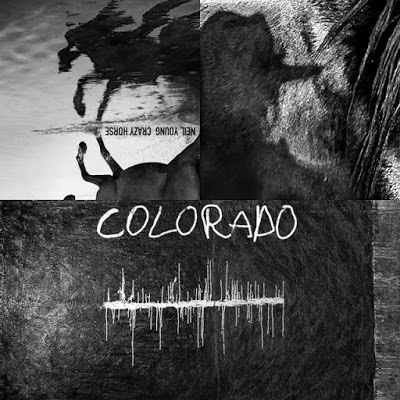 AM prides itself in its celebration of music. In these caustic times, we have a myriad of differences and plenty to argue about, but come on, Led Zeppelin IV… I think we can agree.Remember Mike Damone's 5 Point Plan from Fast Times at Ridgemont High?1. Never let on how much you like a girl.
AM prides itself in its celebration of music. In these caustic times, we have a myriad of differences and plenty to argue about, but come on, Led Zeppelin IV… I think we can agree.Remember Mike Damone's 5 Point Plan from Fast Times at Ridgemont High?1. Never let on how much you like a girl.2. Always call the shots.
3. Act like wherever you are - that's the place to be.
4. When ordering food, find out what she wants then order for both of you. It’s a classy move.
5. When it comes to making out, whenever possible, put on side one of Led Zeppelin IV.Still funny.And while T. Swift gets on my nerves, I understand why she's the biggest star in the world. I'm not a huge rap fan, but Chance the Rapper and Death Cab For Cutie – together – I'm so there. Childish Gambino/Lando Calrissian, yep. New Neil Young, Bruce, Lana Del Rey...People ask then, why isn't there more focus on today's music or, say, the music of the 90s on the AM network? Why focus on 50 years ago?While I would maintain that Radiohead's OK Computer is one of the top ten LPs of all time (putting it alongside Dark Side of the Moon and Sgt. Pepper), and Weezer's Blue Album is one of my personal faves, there was no glut of great music in the 90s - quality, yes; quality and quantity, nah. The grunge renaissance that included Nirvana and Pearl Jam was short-lived and Cobain's demise sounded the death knell to a more promising decade.Ah, but 1969 and the Woodstock Era: Zeppelin's first American tour, the recording of Abbie Road and the Door's L.A. Woman, the Rolling Stones' Let it Bleed, Trout Mask Replica, Tommy, Miles Davis' In a Silent Way, Zappa, Grateful Dead, Bowie, the birth of progressive rock, Genesis - endless.The Allman Brothers, The Carpenters, Crazy Horse, Faces with Rod Stewart, Yes, Jethro Tull, Judas Priest, Hall and Oates, Kraftwerk, Humble Pie and Renaissance all formed around the Woodstock era, simultaneously! And that was only the beginning.So yeah, that's why.
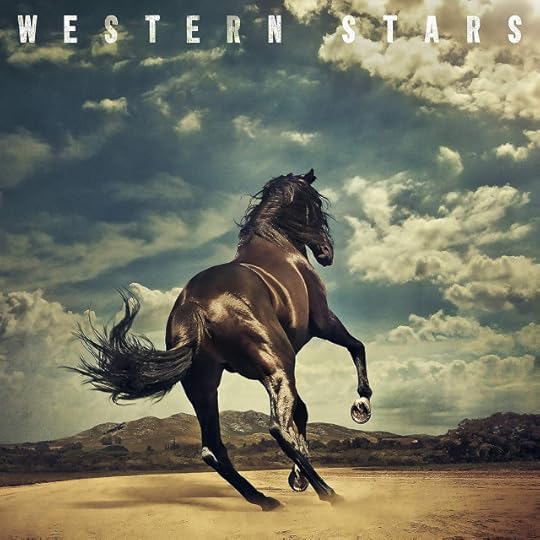 And yet...Bands like Lord Huron and Fleet Foxes harken back to the roots of American music; indeed, Americana can be traced back to Robert Johnson and Woody Guthrie as a truly American art form. In rock music, Americana’s roots begin with Neil Young.
And yet...Bands like Lord Huron and Fleet Foxes harken back to the roots of American music; indeed, Americana can be traced back to Robert Johnson and Woody Guthrie as a truly American art form. In rock music, Americana’s roots begin with Neil Young.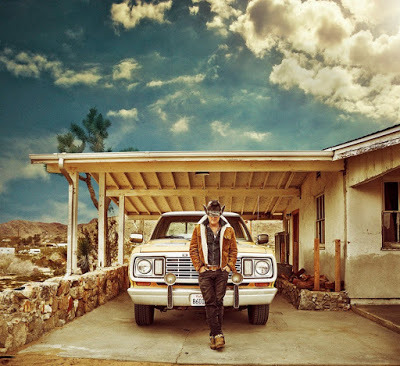 Unlike popular country music today, Americana artists maintain that old country feel; banjo and mandolin, steel guitar and twang, all play into the mystique. This is not your father's country. And the godfather of grunge amazingly provides a taste of what's to come on his new album Colorado with the preview track "Milky Way," a song with a percussive track smooth as aged whiskey and a laid-back quality that would be at home on Zuma or Harvest. Neil breathes new life into a career that began with his eponymous debut LP in 1969, that opening instrumental track sounding like something from the Country Bear Jamboree (a huge compliment from a Liver Lips McGraw fan - Jamboree fans know what I'm talking about).While we have to wait until late October for the LP's release, in the meantime, Americana fans can rejoice in this summer's Western Stars from Bruce Springsteen, the title track a melancholy and beautiful tune that summons up Tom Joad and Nebraska. (I'd even go so far as to say that Western Stars is as good as Nebraska.)You've got to love that nearly 50 years on, Bruce can still write songs that celebrate America without masking its flaws. You remember, an America without the lies.
Unlike popular country music today, Americana artists maintain that old country feel; banjo and mandolin, steel guitar and twang, all play into the mystique. This is not your father's country. And the godfather of grunge amazingly provides a taste of what's to come on his new album Colorado with the preview track "Milky Way," a song with a percussive track smooth as aged whiskey and a laid-back quality that would be at home on Zuma or Harvest. Neil breathes new life into a career that began with his eponymous debut LP in 1969, that opening instrumental track sounding like something from the Country Bear Jamboree (a huge compliment from a Liver Lips McGraw fan - Jamboree fans know what I'm talking about).While we have to wait until late October for the LP's release, in the meantime, Americana fans can rejoice in this summer's Western Stars from Bruce Springsteen, the title track a melancholy and beautiful tune that summons up Tom Joad and Nebraska. (I'd even go so far as to say that Western Stars is as good as Nebraska.)You've got to love that nearly 50 years on, Bruce can still write songs that celebrate America without masking its flaws. You remember, an America without the lies.
Published on September 08, 2019 07:18
September 4, 2019
The Garbage Peace Symbol
 Monday afternoon, August 18, 1969, just a few hours after Hendrix' performance, Woodstock Ventures' partner Michael Lang said he remembers flying out in a helicopter and looking down, noticing the ground crew in the monumental task of cleaning up the site. Amidst the rubble, they'd fashioned a peace symbol made out of the garbage they were collecting, an estimated 700 tons of waste in all. It was a defining moment for Lang regarding the three/four days of peace, love and music. Keep in mind that Lang had planned for 25,000 attendees and hoped to make enough to build a modest recording studio in Woodstock, NY.
Monday afternoon, August 18, 1969, just a few hours after Hendrix' performance, Woodstock Ventures' partner Michael Lang said he remembers flying out in a helicopter and looking down, noticing the ground crew in the monumental task of cleaning up the site. Amidst the rubble, they'd fashioned a peace symbol made out of the garbage they were collecting, an estimated 700 tons of waste in all. It was a defining moment for Lang regarding the three/four days of peace, love and music. Keep in mind that Lang had planned for 25,000 attendees and hoped to make enough to build a modest recording studio in Woodstock, NY. A battle quickly ensued between the four producers over what ended up, despite the success of the concert and the 500,000 attendees, a million-dollar debt for Woodstock Ventures. This had been the counterculture's finest hour, but Lang and partner, Artie Kornfeld ended up selling their stake in the venture for $38,000 a piece, more than they had anticipated. John Roberts and Joel Rosenman, the other partners and financial backers of the exposition, eventually recouped their losses (and still receive residuals from the film), but the financial bonanza Woodstock promised never materialized. The outcome was as muddy a mess as the concert had been.
Still, with all the issues in the aftermath, Woodstock remains a treasured moment in the hearts and minds of many a hippie-soul, a symbol of what the world could be.
Woodstock icon Wavy Gravy said, "Everybody dropped their egos, their petty trips, whatever their trips were. Suddenly it was all dropped and focused on life support. And that was truly exciting. I yearn to do it again."
Published on September 04, 2019 08:31
September 3, 2019
Happy B-Day Woodstock Babies... and other news
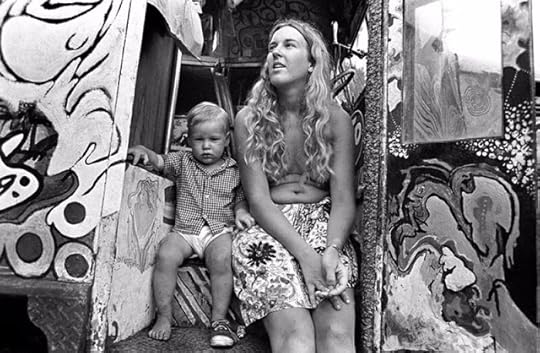 One of Woodstock's legacies remains its lack of violence; indeed the only violence to speak of occurred on stage during The Who when political activist Abbie Hoffman picked up a microphone. Pete Townshend was a self-described curmudgeonly young man, particularly when it came to the sanctity of the stage; no one shared the stage with The Who. Country Joe McDonald recalled: "The Who [were] well into their set, and all of a sudden, this guy shows up and starts talking politics and anti-marijuana laws. I don’t think Townshend was even aware that he was there. He just kind of looked up and 'Who the hell’s this guy?'" It was then that the actual events become a bit sketchy. Townshend purportedly hit Hoffman over the head with his guitar, and with The Who's violent hijinks an expected part of the act, the crowd reacted almost as if it were staged. McDonald said, "Pete walked over and bonked Abbie in the head with his guitar. Abbie’s response was so funny because he just looked at Peter and then jumped into the press pit and went through the crowd and kept going." While there is no video footage, the incident was captured on audiotape and most reports concur with Country Joe's. Hoffman was no longer in his heyday politically and had taken an unknown number of LSD blotter hits while working as a volunteer in a medical tent. He then stormed onto the stage and incoherently questioned the arrest of John Sinclair, an activist who had been arrested on trumped-up marijuana charges. Hoffman, by the way, has a far different version: only that as Townshend was tuning up, he "bumped into me." His rally cries, by the way, failed to stir up any emotional response from the crowd. The politics of Woodstock wasn't about rally cries and fist pumps, it was a spirit of community that created a collected voice, one of peace and love, of flower power if you will. While it's easy to romanticize Woodstock and dismiss those who looked upon instead it as a muddy Babylon, the lack of violence was an undeniable testament to the human spirit.
One of Woodstock's legacies remains its lack of violence; indeed the only violence to speak of occurred on stage during The Who when political activist Abbie Hoffman picked up a microphone. Pete Townshend was a self-described curmudgeonly young man, particularly when it came to the sanctity of the stage; no one shared the stage with The Who. Country Joe McDonald recalled: "The Who [were] well into their set, and all of a sudden, this guy shows up and starts talking politics and anti-marijuana laws. I don’t think Townshend was even aware that he was there. He just kind of looked up and 'Who the hell’s this guy?'" It was then that the actual events become a bit sketchy. Townshend purportedly hit Hoffman over the head with his guitar, and with The Who's violent hijinks an expected part of the act, the crowd reacted almost as if it were staged. McDonald said, "Pete walked over and bonked Abbie in the head with his guitar. Abbie’s response was so funny because he just looked at Peter and then jumped into the press pit and went through the crowd and kept going." While there is no video footage, the incident was captured on audiotape and most reports concur with Country Joe's. Hoffman was no longer in his heyday politically and had taken an unknown number of LSD blotter hits while working as a volunteer in a medical tent. He then stormed onto the stage and incoherently questioned the arrest of John Sinclair, an activist who had been arrested on trumped-up marijuana charges. Hoffman, by the way, has a far different version: only that as Townshend was tuning up, he "bumped into me." His rally cries, by the way, failed to stir up any emotional response from the crowd. The politics of Woodstock wasn't about rally cries and fist pumps, it was a spirit of community that created a collected voice, one of peace and love, of flower power if you will. While it's easy to romanticize Woodstock and dismiss those who looked upon instead it as a muddy Babylon, the lack of violence was an undeniable testament to the human spirit.While the anticipated attendance was 25,000, the population at Bethel Woods swelled to nearly a half-million on Day 3, roughly the population of Atlanta or Miami. Within the four days of the concert, there were but a handful of arrests, no violence, except on stage, one death by OD, and one tragic accident in which a man was asleep in a sleeping bag beneath a work truck. The driver didn’t know the man was there. Those statistics compared to Atlanta or Miami don't make a blip on the radar.
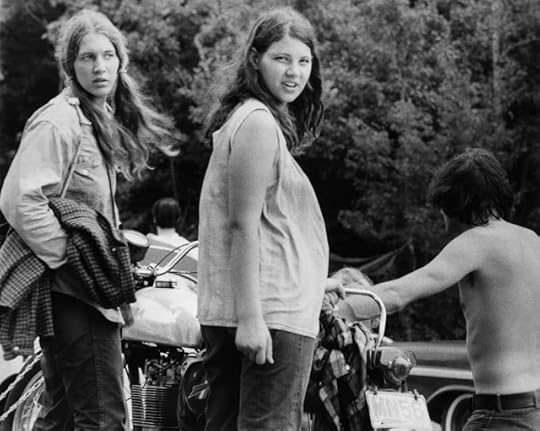
There are reports of two births at the exposition. The babies reportedly born at the Woodstock festival remain a bit of a mystery, although there is some compelling evidence. John Sebastian was captured on film announcing that "Some cat's old lady just had a baby, a kid destined to be far out," and the concert's medical director told reporters there were two births: one at a local hospital after the mother was airlifted by helicopter and the other in a car caught in the epic traffic jam just outside Bethel Woods. Elliot Tiber wrote in his memoir, Taking Woodstock, that he had actually helped deliver a baby at his parent's hotel, very close to the festival. He never asked for the mother's name nor the baby's.
Kind of funny really that no one credible has ever come forward, although there have been many claims. Nonetheless, a Happy B-Day to the Woodstock Babies!
Published on September 03, 2019 16:54
August 30, 2019
Led Zeppelin
During September 1968, The New Yardbirds (Jimmy Page, John Bonham, John Paul Jones and Robert Plant) toured Scandinavia performing Yardbirds material as well as new material like "Communication Breakdown," "I Can't Quit You, Baby," "Babe I'm Gonna Leave You," and "How Many More Times." That same month, at Keith Moon's mocking ("That'll go down like a lead zeppelin), The New Yardbirds were renamed Led Zeppelin, and on October 15, 1968, Led Zeppelin made their debut at Surrey University. Soon after, the group began touring the U.S., backing up headliners like Vanilla Fudge and The MC5. Nearly instantaneous recognition followed. On January 31, 1969, Led Zeppelin opened for Iron Butterfly, who, due to "In a Gadda Da Vida," were one of the hottest bands in the world. Led Zeppelin received such resounding approval from the audience that Doug Ingle, lead singer for the Butterfly scrapped the remainder of the tour. Led Zeppelin had become headliners in their own right.
Led Zeppelin would end up opening for Vanilla Fudge with the band name mistakenly advertised as "Len Zeffelin." Doesn't quite have the same ring to it. No one had ever heard anything like it. By the time Zeppelin left the stage, psychedelia was dead and heavy metal was born. Poor Vanilla Fudge.
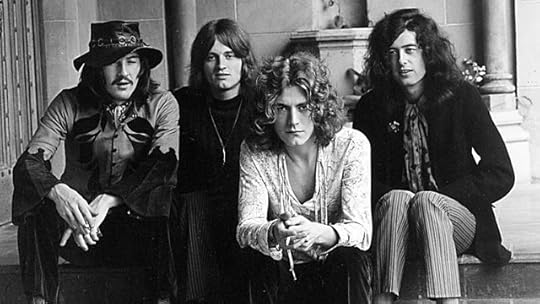
Within eight months of their official debut, Zeppelin was at the top of the bill at the Playhouse Theater in London, and the Pop Proms at the Royal Albert Hall. On October 17, 1969, a year after the band's inception, Zeppelin played Carnegie Hall, ending a ban on rock groups caused by the Rolling Stones' antics in 1965.
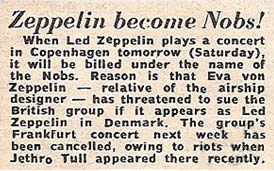 While playing in Denmark, Eva von Zeppelin, a relative of the designer of the airship, Ferdinand von Zeppelin, threatened to sue the band if they used the name for their gig in Copenhagen. For that one show, Led Zeppelin played under the alias, The Nobs.
While playing in Denmark, Eva von Zeppelin, a relative of the designer of the airship, Ferdinand von Zeppelin, threatened to sue the band if they used the name for their gig in Copenhagen. For that one show, Led Zeppelin played under the alias, The Nobs.
The first LP took but 36 hours of studio time, including mixing and mastering and was fit into the band's hectic touring schedule. The band was without a label and on the clock to the tune of £1,782, or roughly $3,500. Released January 12, 1969, in the U.S., Led Zeppelin climbed to No. 10 in the U.S. and to No. 6 in the U.K. (Released March 28th). Until the late 60s, producers placed microphones directly in front of the amplifiers and drums. For Led Zeppelin, Page placed an additional microphone some distance from the amplifier (as far as twenty feet) and then recorded the balance between the two. By adopting this "distance equals depth" technique, Page was among the first producers to record a band's "ambient sound;" the distance of a note's time-lag from one end of the room to the other. Led Zeppelin was the first album to be released in stereo-only form; at the time, the practice of releasing both mono and stereo versions was the norm. The LP was the virtual Sgt. Pepper of Heavy Metal Blues.
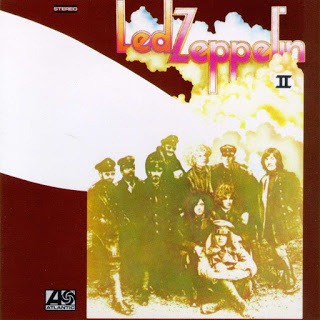 Somehow, this band of misfits broke down the walls of critics (who abhorred the first LP) going straight for the audience, and won with their interpolation of blues, garage rock, soul, shuffle, psychedelic vibes and violin-bowed guitar fer chrissakes; they were over-the-top and minimalist, often in the same song. With tracks about hobbits, mythology and sex in equal form, Led Zeppelin made it look easy.
Somehow, this band of misfits broke down the walls of critics (who abhorred the first LP) going straight for the audience, and won with their interpolation of blues, garage rock, soul, shuffle, psychedelic vibes and violin-bowed guitar fer chrissakes; they were over-the-top and minimalist, often in the same song. With tracks about hobbits, mythology and sex in equal form, Led Zeppelin made it look easy.
Led Zeppelin's debut album (AM8) is a monster of barely contained monolithic intensity (yeah pompous as shit). The album's artistic success hinges on the tension between the reflective/creative/experimental natures of Jimmy Page and John Paul Jones rubbing elbows with the bombastic/flamboyant/amped-up traditionalism of Robert Plant and John Bonham. When these tensions interact fireworks ensue. These are basic musical forms, blues, folk and bluegrass, taken to new extremes of sonic density and timbrel heaviness. Here was a conscious move to unearth the swamp blues from which all rock and roll originated and, at the same time, revitalize the format for a contemporary audience. The likes of The Yardbirds, The Small Faces, John Mayall's Bluesbreakers and Joe Cocker fronted a movement that occasionally bruised the singles chart, but was primarily an underground faction. Hendrix, Beck and Cream pushed this to another, darker dimension and Zeppelin's debut was an integral player in the cadre that opened the floodgates to a bevy of progressive bands whose growing obsession with self-indulgent, sprawling epics lead to an inevitable implosion and the backlash that was punk. That's a lot of rock history in one breath: Led Zeppelin was the catalyst for it all. By year's end, the band released Led Zeppelin II (Led Zeppelin II, quickly moved up to No. 1 in both the U.S. and the U.K., remaining on the charts for 98 weeks in the States and an astounding 138 weeks in Britain.)
 As we've reported, Led Zeppelin chose to skip Woodstock for their first American tour, playing the Asbury Park Convention Center instead with a crowd of 1500. Just after Woodstock, the band played The Carousel in Framingham, Massachusetts. You can read an account of what that was like in my novel Miles From Nowhere.
As we've reported, Led Zeppelin chose to skip Woodstock for their first American tour, playing the Asbury Park Convention Center instead with a crowd of 1500. Just after Woodstock, the band played The Carousel in Framingham, Massachusetts. You can read an account of what that was like in my novel Miles From Nowhere.
Late in '69 we'd just moved to a new apartment in North Hollywood. There was no furniture in the living room, bar the white Mediterranean style console stereo. My mother was putting up new curtains and my brother put on Zeppelin II. The acoustic effects (because of the empty room) were amazing, and the transfer of sound from one speaker to the other intensified my fascination. My mother yelled, "Turn that down." There may have been the insertion of an expletive. Nothing seals one's affinity for a rock LP like the criticism of a parent. Just eight years old at the time, I was sold.
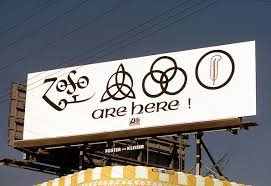 Want to know what hard rock is? Led Zeppelin II (AM8), no bones about it. Zep II delivers in spades with bountiful and bludgeoning force, sex-hot passion, and intricate grace. "Whole Lotta Love" immediately seduces with Page's strutting chops, driving drums and Plant's mile-high wails before hurtling the listener into a sparse and shaky atmosphere of twitching percussion and mind bending guitar squeals. And that's just the first track. Just try to sit still through "The Lemon Song," absorb the beautifully understated "Thank You" and don't forget the Bonham showcase "Moby Dick." This album exhibits a handful of the most influential songs in rock history with blues-soaked attitude to spare, indulgences in instrumentation that have yet to be surpassed, and compositions designed to rock your ass. Zep II is why the boys had their own private jet.
Want to know what hard rock is? Led Zeppelin II (AM8), no bones about it. Zep II delivers in spades with bountiful and bludgeoning force, sex-hot passion, and intricate grace. "Whole Lotta Love" immediately seduces with Page's strutting chops, driving drums and Plant's mile-high wails before hurtling the listener into a sparse and shaky atmosphere of twitching percussion and mind bending guitar squeals. And that's just the first track. Just try to sit still through "The Lemon Song," absorb the beautifully understated "Thank You" and don't forget the Bonham showcase "Moby Dick." This album exhibits a handful of the most influential songs in rock history with blues-soaked attitude to spare, indulgences in instrumentation that have yet to be surpassed, and compositions designed to rock your ass. Zep II is why the boys had their own private jet.
Don't forget your copy of Miles available on Amazon. Click the link in the sidebar for the softbound and Kindle editions.
Led Zeppelin would end up opening for Vanilla Fudge with the band name mistakenly advertised as "Len Zeffelin." Doesn't quite have the same ring to it. No one had ever heard anything like it. By the time Zeppelin left the stage, psychedelia was dead and heavy metal was born. Poor Vanilla Fudge.

Within eight months of their official debut, Zeppelin was at the top of the bill at the Playhouse Theater in London, and the Pop Proms at the Royal Albert Hall. On October 17, 1969, a year after the band's inception, Zeppelin played Carnegie Hall, ending a ban on rock groups caused by the Rolling Stones' antics in 1965.
 While playing in Denmark, Eva von Zeppelin, a relative of the designer of the airship, Ferdinand von Zeppelin, threatened to sue the band if they used the name for their gig in Copenhagen. For that one show, Led Zeppelin played under the alias, The Nobs.
While playing in Denmark, Eva von Zeppelin, a relative of the designer of the airship, Ferdinand von Zeppelin, threatened to sue the band if they used the name for their gig in Copenhagen. For that one show, Led Zeppelin played under the alias, The Nobs.The first LP took but 36 hours of studio time, including mixing and mastering and was fit into the band's hectic touring schedule. The band was without a label and on the clock to the tune of £1,782, or roughly $3,500. Released January 12, 1969, in the U.S., Led Zeppelin climbed to No. 10 in the U.S. and to No. 6 in the U.K. (Released March 28th). Until the late 60s, producers placed microphones directly in front of the amplifiers and drums. For Led Zeppelin, Page placed an additional microphone some distance from the amplifier (as far as twenty feet) and then recorded the balance between the two. By adopting this "distance equals depth" technique, Page was among the first producers to record a band's "ambient sound;" the distance of a note's time-lag from one end of the room to the other. Led Zeppelin was the first album to be released in stereo-only form; at the time, the practice of releasing both mono and stereo versions was the norm. The LP was the virtual Sgt. Pepper of Heavy Metal Blues.
 Somehow, this band of misfits broke down the walls of critics (who abhorred the first LP) going straight for the audience, and won with their interpolation of blues, garage rock, soul, shuffle, psychedelic vibes and violin-bowed guitar fer chrissakes; they were over-the-top and minimalist, often in the same song. With tracks about hobbits, mythology and sex in equal form, Led Zeppelin made it look easy.
Somehow, this band of misfits broke down the walls of critics (who abhorred the first LP) going straight for the audience, and won with their interpolation of blues, garage rock, soul, shuffle, psychedelic vibes and violin-bowed guitar fer chrissakes; they were over-the-top and minimalist, often in the same song. With tracks about hobbits, mythology and sex in equal form, Led Zeppelin made it look easy.Led Zeppelin's debut album (AM8) is a monster of barely contained monolithic intensity (yeah pompous as shit). The album's artistic success hinges on the tension between the reflective/creative/experimental natures of Jimmy Page and John Paul Jones rubbing elbows with the bombastic/flamboyant/amped-up traditionalism of Robert Plant and John Bonham. When these tensions interact fireworks ensue. These are basic musical forms, blues, folk and bluegrass, taken to new extremes of sonic density and timbrel heaviness. Here was a conscious move to unearth the swamp blues from which all rock and roll originated and, at the same time, revitalize the format for a contemporary audience. The likes of The Yardbirds, The Small Faces, John Mayall's Bluesbreakers and Joe Cocker fronted a movement that occasionally bruised the singles chart, but was primarily an underground faction. Hendrix, Beck and Cream pushed this to another, darker dimension and Zeppelin's debut was an integral player in the cadre that opened the floodgates to a bevy of progressive bands whose growing obsession with self-indulgent, sprawling epics lead to an inevitable implosion and the backlash that was punk. That's a lot of rock history in one breath: Led Zeppelin was the catalyst for it all. By year's end, the band released Led Zeppelin II (Led Zeppelin II, quickly moved up to No. 1 in both the U.S. and the U.K., remaining on the charts for 98 weeks in the States and an astounding 138 weeks in Britain.)
 As we've reported, Led Zeppelin chose to skip Woodstock for their first American tour, playing the Asbury Park Convention Center instead with a crowd of 1500. Just after Woodstock, the band played The Carousel in Framingham, Massachusetts. You can read an account of what that was like in my novel Miles From Nowhere.
As we've reported, Led Zeppelin chose to skip Woodstock for their first American tour, playing the Asbury Park Convention Center instead with a crowd of 1500. Just after Woodstock, the band played The Carousel in Framingham, Massachusetts. You can read an account of what that was like in my novel Miles From Nowhere. Late in '69 we'd just moved to a new apartment in North Hollywood. There was no furniture in the living room, bar the white Mediterranean style console stereo. My mother was putting up new curtains and my brother put on Zeppelin II. The acoustic effects (because of the empty room) were amazing, and the transfer of sound from one speaker to the other intensified my fascination. My mother yelled, "Turn that down." There may have been the insertion of an expletive. Nothing seals one's affinity for a rock LP like the criticism of a parent. Just eight years old at the time, I was sold.
 Want to know what hard rock is? Led Zeppelin II (AM8), no bones about it. Zep II delivers in spades with bountiful and bludgeoning force, sex-hot passion, and intricate grace. "Whole Lotta Love" immediately seduces with Page's strutting chops, driving drums and Plant's mile-high wails before hurtling the listener into a sparse and shaky atmosphere of twitching percussion and mind bending guitar squeals. And that's just the first track. Just try to sit still through "The Lemon Song," absorb the beautifully understated "Thank You" and don't forget the Bonham showcase "Moby Dick." This album exhibits a handful of the most influential songs in rock history with blues-soaked attitude to spare, indulgences in instrumentation that have yet to be surpassed, and compositions designed to rock your ass. Zep II is why the boys had their own private jet.
Want to know what hard rock is? Led Zeppelin II (AM8), no bones about it. Zep II delivers in spades with bountiful and bludgeoning force, sex-hot passion, and intricate grace. "Whole Lotta Love" immediately seduces with Page's strutting chops, driving drums and Plant's mile-high wails before hurtling the listener into a sparse and shaky atmosphere of twitching percussion and mind bending guitar squeals. And that's just the first track. Just try to sit still through "The Lemon Song," absorb the beautifully understated "Thank You" and don't forget the Bonham showcase "Moby Dick." This album exhibits a handful of the most influential songs in rock history with blues-soaked attitude to spare, indulgences in instrumentation that have yet to be surpassed, and compositions designed to rock your ass. Zep II is why the boys had their own private jet.Don't forget your copy of Miles available on Amazon. Click the link in the sidebar for the softbound and Kindle editions.
Published on August 30, 2019 06:21
August 28, 2019
Miles From Woodstock

- from Miles From Nowhere
I knew that once I turned my back on Woodstock, it would be gone. I grabbed my shoes and the sandwich and coursed my way through the rubble. I climbed on the stage, sat Indian style looking out over what had been the Aquarian metropolis and ate my sandwich, peanut butter and honey on whole wheat.
Gods and giants had walked this stage, but now it was done. “Y’ever seen such a mess?” It was an old man in coveralls. “Three days of peace and clutter.” Sometimes when people talk to you, it’s a signal to be on your way; comes a time to move along. I put on my shoes and peed off the back of the stage. The old man said, “Never seen nothin’ like it.”
Two miles on, the cluster of abandoned vehicles diminished and the road began to work like a road. I did something I’d never done. It was a long way back to the van, and I stuck out my thumb. Wasn’t long, less than a minute, when a yellow Datsun passed and then stopped. The passenger door opened a girl hopped out and got in back. Each was cute and covered in mud like aborigines. “Where you headed?”
“Like ten miles. Where you headed?”
“Jersey. Down the shore.”
“I been there.” We talked about Hendrix and they talked about the Airplane and filled me in. They talked about the mud and the rain and the cute drummer in Santana and the brown acid; how they’d been wearing the same clothes since Friday. They talked and giggled like girls and I felt like it was time for me to move along. “Right over here’s fine.”
The girl driving said, “You all right?”
“Yeah, thanks. Just right over here.”
“We can take you wherever you want.”
“Yeah, it’s okay. This is fine.”
“You look a little pale.”
“I’m fine. But thanks.” I walked along lost in thought. Cars whirred by. The sky was blue and all the countryside had turned a bright green. There was a cacophony of music in my head as I walked along. I threw up by a tree. When I looked up, the Standard station was just across the way. All the cars were gone but mine. The attendant was checking someone’s oil. I waved, got in the van and headed down the road. I was happy as a lark, but I needed to take a shower and lie in a bed and watch some color TV. My destination was clear to me. I headed back to the AAA, two diamond, Neversink Motor Court. I’d grab a good meal at the luncheonette and plop myself on the bed with the clicker.
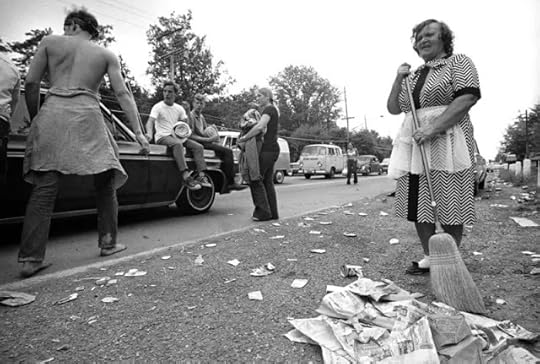
I pulled under the canopy. The motel keeper was hosing down the drive and he came to the window. “You got any rooms?”
“All a ’em.” I went over to the luncheonette. I ordered an open-faced turkey sandwich with mashed potatoes and cranberry sauce.
“You look like you could use a good meal. A little peaked.” I was tired of that already. I sat at the counter. There were farmhands and locals, no hippies, and people were looking at me. I’d forgotten how dirty I was. There was dirt in my fingernails and in my ears. There was mud in my shoes.
“Maybe hold off on that,” I said. “Maybe I’ll go take a shower. Gimme like half an hour.” I walked back to the motor court and get the key. I rolled my clothes in a ball and threw them in the back of the closet. I took a hot shower. Took a while to scrub off the caked-on mud; don’t even know if I got it all. I put on my khaki slacks and my paisley shirt and my Weejuns and sauntered back to the luncheonette. Waitress had my food waiting for me. She was talking to a man at the counter eating a hamburger. “All in all seemed like good kids.”
“Seemed that way to me, too. Polite and all.” Good kids. I guess it was relative. If good kids meant open sex and dollar hits of acid and saying thank you, then yeah. Good as any. Or maybe the good kids stayed home, maybe the good kids went to war. Maybe we were the bad kids, the kids who borrowed the family sedan or ran away or I don’t know. Everybody was nice, that part was true; they gave me rides and sandwiches and shelter. Maybe that’s what good is.
“They say people died. Kid got run over by a tractor.”
“At’s a shame.”
“And two babies born. That’s sumpin’ to tell your grandkids. Born in the mud on Yasgur’s milk farm, colored fella playin’ guitar in the background.”
That night I ate candy bars, two Three Musketeers and watched TV, all tucked into nice white sheets.
Published on August 28, 2019 02:01



